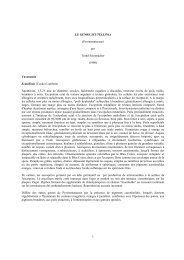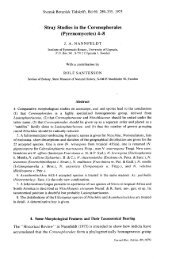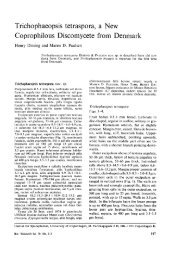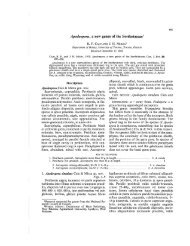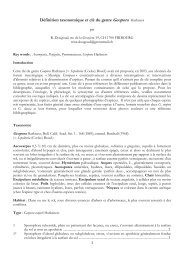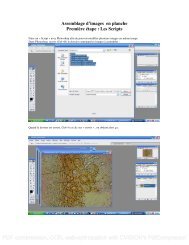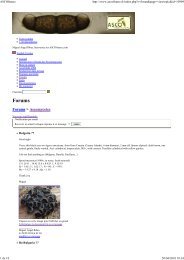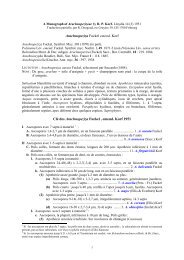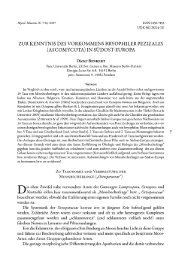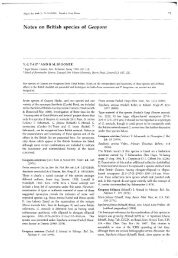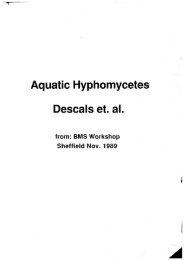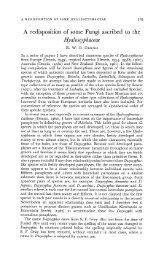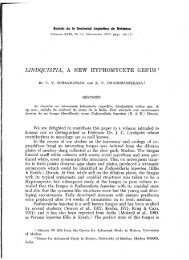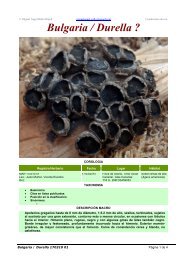Australian discomycetes on dead logs and branches - ASCOfrance
Australian discomycetes on dead logs and branches - ASCOfrance
Australian discomycetes on dead logs and branches - ASCOfrance
- No tags were found...
You also want an ePaper? Increase the reach of your titles
YUMPU automatically turns print PDFs into web optimized ePapers that Google loves.
[ 449 ]<br />
Trans. Br. mycol. Soc. 67 (3) 449-454 (1976)<br />
Printed in Great Britain<br />
AUSTRALIAN DISCOMYCETES ON DEAD LOGS AND BRANCHES<br />
By G. BEATON<br />
Hild<strong>on</strong>, Victoria<br />
AND GRETNA WESTE<br />
School of Botany, University of Melbourne<br />
These five small <str<strong>on</strong>g>discomycetes</str<strong>on</strong>g> are cup- or disk-shaped <strong>and</strong> range from 0'5 to 5'0 mm diam,<br />
They were collected from twig or wood debris lying <strong>on</strong> the ground of natural eucalypt<br />
forests. All are first records for Victoria.<br />
In Ceri<strong>on</strong> coccineum Mass. & Rod., the apothecia<br />
are inunersed in the substrate <strong>and</strong> appear as deep<br />
orange disks with a blackened margin, <strong>and</strong> the<br />
single paraphyses c<strong>on</strong>tain orange pigment. The<br />
fungus has previously been recorded in Tasmania<br />
by Massee (1901). Bulgariella pulla (Fr.) Karst.<br />
produces superficial apothecia <strong>on</strong> black disks with<br />
a surrounding ring of dark brown anchoring<br />
hyphae. In Propolis versicolor (Fr.) Fr. the<br />
apothecia are immersed in the form of oval greywhite<br />
disks surrounded by a rim of tom host<br />
tissue . This species has been collected both in wet<br />
forests <strong>and</strong> <strong>on</strong> exposed roots am<strong>on</strong>g s<strong>and</strong> dunes.<br />
Strossmayeria basitricha (Sacc.) Dennis c<strong>on</strong>sists of<br />
superficial, white to light orange coloured cupshaped<br />
apothecia associated with dematiaceous<br />
moulds. Diplocarpa bloxamii (Berk.) Seav. produces<br />
clusters of apothecia supported by black<br />
rhizomorph-like structures, which are not menti<strong>on</strong>ed<br />
in the descripti<strong>on</strong>s of the English <strong>and</strong><br />
North American specimens.<br />
CERION COCClNEUM Massee & Redway, Ke w Bull.<br />
1901 : 159 (1901). (Fig. 1)<br />
Apothecia scattered or in groups, immersed,<br />
becoming erumpent through bark, circular or<br />
irregularly shaped; disk flat, to 2'5 mm diam,<br />
deep orange when fresh with little colour change<br />
<strong>on</strong> dried apothecia, surrounded by a black, erect,<br />
usually uneven but c<strong>on</strong>tinuous rim; flesh a<br />
narrow indistinct layer of hyaline, interwoven<br />
hyphae with embedded amorphous masses of<br />
crystals in the basal area, becoming parallel in the<br />
marginal area where the slightly thicker tips are<br />
inunersed in an opaque brown pigment ; excipulum<br />
a layer of agglutinated, pigmented, thickwalled<br />
hyphae to 100/lm thick which completely<br />
surrounds the disc <strong>and</strong> the parallel marginal<br />
hyphae. Asci almost cylindrical, not capitate, pore<br />
not blued by Melzer's reagent, 8-spored, 180-200<br />
X 8-10 /lm. Ascospores cylindrical or slightly<br />
tapering towards the lower end, straight or slightly<br />
curved, hyaline, aseptate, filled with small guttules,<br />
100-110 x 1'5-2 usn. Paraphyses simple,<br />
cylindrical with clavate tips filled with .reddish<br />
c<strong>on</strong>tents that dissolve out in lactophenol, sparsely<br />
septate, up to 40/lm l<strong>on</strong>ger than the asci, 2'5 /lm<br />
diam, tips to 5 /lm.<br />
On the bark of <strong>dead</strong> twigs <strong>and</strong> small <strong>branches</strong><br />
from late Autumn to early Spring. Widespread<br />
throughout Victoria <strong>and</strong> <strong>on</strong>ce not uncomm<strong>on</strong> but<br />
apparently now rather rare.<br />
Massee descr ibed the ascospores as 'for a l<strong>on</strong>g<br />
time c<strong>on</strong>tinuous then multiseptate, finally' breaking<br />
up at the septa into cells about 8-10 /lm l<strong>on</strong>g '.<br />
Repeated examinati<strong>on</strong>s of collecti<strong>on</strong>s up to twelve<br />
years old <strong>and</strong> lactophenol mounts of similar age<br />
have always revealed c<strong>on</strong>tinuous spores with no<br />
indicati<strong>on</strong> ofa tendency to break into part-spores.<br />
Collecti<strong>on</strong>s examined: On twigs, Molesworth-Caveat<br />
area, G. Cricht<strong>on</strong>, May 1963 ; Lerderderg Gorge , R.<br />
Fils<strong>on</strong>, July 1963 j Royst<strong>on</strong> rd, nr Rubic<strong>on</strong>, Victoria ,<br />
G. Beat<strong>on</strong> , 121, Aug. 1963 ; Big River, Eild<strong>on</strong>-Jamies<strong>on</strong><br />
rd, K , & G. Beat<strong>on</strong>, Eoo67, May 1974.<br />
BULGARIELLA PULLA (Fr.) Karst., Acta Soc. Fauna<br />
Fl. Fenn. :z :142 (1885). (Fig. 2)<br />
Patellaria pulla Fr., Syst, Mycol. :z :160 (1822).<br />
Bulgaria pulla (Fr.) Fr., Summa Veg. Sc<strong>and</strong>.,<br />
Sect. Post. 358 (1849).<br />
Apothecia superficial, scattered or caespitose, to<br />
3"5mm diam ; disk black, flat or slightly c<strong>on</strong>vex;<br />
receptacle black, finely scurfy, saucer-shaped <strong>on</strong> a<br />
broad base, with a surrounding narrow ring of<br />
black or dark brown anchoring hyphae <strong>and</strong> with a<br />
definite margin surrounding the disk ; hypothecium<br />
a narrow layer of densely interwoven, lightly<br />
pigmented hyphae to 3 /lm thick; medullary<br />
excipulum of loosely interwoven hyphae to 12 /lID
45° <str<strong>on</strong>g>Australian</str<strong>on</strong>g> <str<strong>on</strong>g>discomycetes</str<strong>on</strong>g> <strong>on</strong> <strong>dead</strong> <strong>logs</strong> <strong>and</strong> <strong>branches</strong><br />
c<br />
B~<br />
25,urn<br />
I<br />
Fig. 1. Ceri<strong>on</strong> coccineum. (A)Parallelmarginalhyphae with pigmented tips; (B) pigmentedthick-walled<br />
hyphae of basal area; (C) tips of paraphyses; (D) ascus; (E) ascospore; (F) apothecia.<br />
thick embedded in a brown gelatinous matrix;<br />
ectal excipulum in the free basal area a layer, 75<br />
/lm thick, of parallel but slightly undulating<br />
hyphae with cells to 50 x 15 /lm. Asci cylindrical<br />
with rounded tips, 8-spored, negative iodine<br />
reacti<strong>on</strong>, 140-160 x 9-10'5 /lm. Ascospores oval,<br />
dark sooty brown, uniseriate, free spores showing<br />
de Bary bubbles when mounted in lactophenol,<br />
10-15'5 x 5'5-9'5 /lm. Paraphyses cylindrical with<br />
obtuse tips c<strong>on</strong>taining coloured oil drops, a few<br />
branched from tips, 2 /lm thick.<br />
This collecti<strong>on</strong> differs from English material in<br />
having a broad base surrounded with anchoring<br />
hyphae, in the thicker hyphae of the medullary<br />
excipulum <strong>and</strong> in the absence of superficial cells<br />
<strong>on</strong> the receptacle ' with dark brown granular<br />
c<strong>on</strong>tents, their tips sometimes free' (Dennis,<br />
1956). Because of possible variati<strong>on</strong> in these<br />
differences it would be unwise to describe the<br />
Victorian fungus as new <strong>on</strong> the basis of a single<br />
collecti<strong>on</strong>.<br />
Collecti<strong>on</strong> examined: On decorticated trunk of<br />
unidentified tree, above Snob's Falls, near Eild<strong>on</strong>,<br />
Victoria, G. Beat<strong>on</strong>, 377, Oct. 1975.<br />
PROPOLIS VERSICOLOR (Fr.) Fr., Summa Veg.<br />
Sc<strong>and</strong>. Sect. Post. : 372 (1849). (Fig. 3)<br />
Apothecia scattered, immersed in substrate, when<br />
mature surrounded by a torn margin of superficial<br />
host tissue; disk elliptical or slightly irregular,<br />
flat, to about 5 mm diam, pruinose, greywhite<br />
superficially, darker beneath; subhymenium<br />
a thin layer of interwoven, hyaline hyphae to 1 /lm<br />
thick. ' Marginal tissue lining <strong>and</strong> closely adhering<br />
to the upturned margin of host tissue <strong>and</strong> itself<br />
forming a vertical rim to the disk' (Dennis, 1968).<br />
Asci cylindrical-clavate with rounded tips, 8-<br />
spored, negative iodine reacti<strong>on</strong>, walls to 1'5 /lm<br />
thick, 95-115 x 13-16 /lm.<br />
Ascospores elliptical, obl<strong>on</strong>g-elliptical or allantoid,<br />
hyaline, smooth, aseptate, c<strong>on</strong>taining several<br />
oil drops, biseriate, 18-22 x 5-7 /lm. Paraphyses
G. Beat<strong>on</strong> <strong>and</strong> Gretna Weste 45 1<br />
A<br />
c<br />
l-...-.J<br />
3 mm<br />
B<br />
25 tim<br />
10 tim<br />
25 tim<br />
Fig. 2. Bulgariella pulla. (A) Ectal excipulum; (B) hyphae of medullary excipulum; (C) apothecium;<br />
(D) ascus <strong>and</strong> paraphyses; (E) ascospores, two in optical secti<strong>on</strong>.<br />
5mm<br />
c<br />
25 tim<br />
Fig. 3. Propolis versicolor. (A) Apothecia; (B) asci; (C) paraphyses; (D) ascospores.
452 <str<strong>on</strong>g>Australian</str<strong>on</strong>g> <str<strong>on</strong>g>discomycetes</str<strong>on</strong>g> <strong>on</strong> <strong>dead</strong> <strong>logs</strong> <strong>and</strong> <strong>branches</strong><br />
D<br />
l---J<br />
O,5mm<br />
A<br />
1011m<br />
IOl1m<br />
10 11m<br />
Fig, 4. Strossmyeria basitricha. (A) Parallel hyphae of base <strong>and</strong> margin showinglumen stained with cott<strong>on</strong><br />
blue; (B) ascus <strong>and</strong> paraphyses; (C) ascospores, <strong>on</strong>e immature; (D) apothecia.<br />
numerous, cylindrical with much branched, c<strong>on</strong>torted<br />
tips, 1 /lm thick, tips to about 2 usn, to 25<br />
/lm l<strong>on</strong>ger than the asci.<br />
On vegetable debris <strong>and</strong> <strong>on</strong> <strong>dead</strong>, exposed<br />
roots <strong>on</strong> road cuttings <strong>and</strong> s<strong>and</strong> dunes in the<br />
spring. Once was not uncomm<strong>on</strong> but during the<br />
past 10 years has apparently become rather rare<br />
in Victoria. The Victorian collecti<strong>on</strong>s differ from<br />
European material in the smaller size of the<br />
ascospores <strong>and</strong> asci, but agree well in other respects<br />
<strong>and</strong> can be c<strong>on</strong>sidered c<strong>on</strong>specific with<br />
European collecti<strong>on</strong>s.<br />
Collecti<strong>on</strong>s examined: On Eucalyptus twig, Mait's<br />
Rest, or Apollo Bay, Victoria, G. Beat<strong>on</strong>, Sept. 1962;<br />
between dunes <strong>and</strong> road <strong>on</strong> exposed roots, West of<br />
Anglesea, Victoria, G. Beat<strong>on</strong>, July 1964.<br />
STROSSMAYERIA BASITRICHA (Sacc.) Dennis, British<br />
Cup fungi <strong>and</strong> their allies: 73 (1960). (Fig. 4)<br />
Bel<strong>on</strong>ium basitrichum (Sacc.) Seaver North<br />
American Cup-Fungi (Inoperculates) :170<br />
(1951).<br />
Bel<strong>on</strong>idium basitrichum Sacc., Atti Soc. Venet.-<br />
Trent. Sci. Nat. Padova 4 :135 (1875).<br />
Apothecia superficial, scattered, sessile or substipitate,<br />
white when fresh, drying light orange,<br />
0'5 mm diam x 0'5 mm high; receptacle smooth,<br />
composed of parallel hyaline hyphae, thin-walled<br />
in the basal area becoming thicker-walled <strong>and</strong><br />
slightly refractive towards the margin, to 4 Jim<br />
diam. Asci clavate, 8-spored, pore not bluing in<br />
Melzer's reagent, 90-110 x 10-12 pm. Ascospores<br />
fusiform, hyaline, 2-3 seriate, mostly 7-septate,<br />
when fully mature 30-40 x 4-5'5 pm. Paraphyses<br />
cylindrical with clavate tips, simple, septate,<br />
hyaline, same length as asci, 1'5 Jim diam, tips to<br />
5'5 pm .<br />
Known in Victoria from <strong>on</strong>ly <strong>on</strong>e scanty collecti<strong>on</strong><br />
which does not seem to differ in any significant<br />
way from published descripti<strong>on</strong>s of the<br />
species. Associated with dematiaceous moulds<br />
that could not be determined with certainty.<br />
Collecti<strong>on</strong> examined : On decorticated Eucalyptus<br />
branch, Snob's Creek Fish Hatchery Reserve, near<br />
Eild<strong>on</strong>, K. & G. Beat<strong>on</strong>, 362, May 1974.
G. Beat<strong>on</strong> <strong>and</strong> Gretna Weste<br />
453<br />
B<br />
25 JlI1l<br />
10JIm<br />
10 JIm<br />
Fig. 5, Diplocarpa bloxamii. (A) Cells of excipulum <strong>and</strong> hairs; (B) ascus <strong>and</strong> paraphyses; (C) tips of<br />
paraphyses (detached); (D) detail of hair; (E) ascospores ; (F) apothecia <strong>and</strong> 'rhizomorphs'.<br />
DIPLOCARPA BLOXAMII (Berk.) Seaver (as<br />
•bloxami'), Mycologia 29 :177 (1937)<br />
Dasyscypha diplocarpa (Currey) Boud., Hist. &<br />
Classif. Discom. d'Europe 121 (1907).<br />
Peziza diplocarpa Currey, Trans. Linn. Soc.<br />
L<strong>on</strong>d . 24: 153 (1864).<br />
Lachnella diplocarpa (Currey) Phill., Brit.<br />
Discom. 232 (1887).<br />
Encoelia bloxamii (Berk.) Phill., Brit. Discom.<br />
338 (1887)·<br />
Cenangium bloxamii (Berk.) Sacc., Syll. fungo<br />
S :568 (1889).<br />
Diplocarpa curreyana Mass., Brit. Fung.-Flora<br />
4 :307 (1895).<br />
Apothecia in groups supported <strong>on</strong> black muchbranched<br />
<strong>and</strong> c<strong>on</strong>torted, partly superficial, partly<br />
erect rhizomorph-like threads composed of lightly<br />
pigmented subparallel <strong>and</strong> interwoven hyphae in<br />
a dense brown matrix, with cells to 50 x 6 pm<br />
(complete structure not clearly seen); disk to 2<br />
rom diam, dark grey-green, depressed; receptacle<br />
at first globose becoming clavate then cupshaped<br />
at maturity, short-stalked or almost sessile<br />
<strong>on</strong> the 'rhizomorphs', densely covered except at<br />
the base of the stalk with a grey-green tomentum,<br />
lighter than the disk; excipulum a brown pigmented<br />
textura angularis with cells to 15 pm<br />
diam; basal hairs stiff, cylindrical, lightly pigmented,<br />
thick-walled, septate, with acute tips<br />
smooth or covered with scattered hyaline granules,<br />
to 120 X 5 pm, marginal hairs of similar structure<br />
but much shorter, releasing a green pigment into<br />
2! % KOH. Asci cylindrical-clavate narrowed to<br />
a short stalk, 8-spored, negative iodine reacti<strong>on</strong>,<br />
70-90 x 6-8 pm. Ascospores broadly elliptical,<br />
uniseriate, hyaline, 7-9'5 x 3-3'5 pm. Paraphyses<br />
cylindrical with tips exp<strong>and</strong>ed into a septate,<br />
fusiform body, detachable <strong>and</strong> sometimes breaking<br />
apart at the septa, 1'5 pm diam, tips to 30 x 5 usn.<br />
Victorian specimens of D. bloxamii differ in<br />
several respects from English <strong>and</strong> North American<br />
collecti<strong>on</strong>s. Dennis (1968) gives the receptacle as<br />
'dark olive-brown sometimes with a reddishbrown<br />
margin' <strong>and</strong> Seaver (1937) gives it as dark<br />
brown. This c<strong>on</strong>trasts with Victorian collecti<strong>on</strong>s
454 <str<strong>on</strong>g>Australian</str<strong>on</strong>g> <str<strong>on</strong>g>discomycetes</str<strong>on</strong>g> <strong>on</strong> <strong>dead</strong> <strong>logs</strong> <strong>and</strong> <strong>branches</strong><br />
which remain grey-green when dried. The hairs<br />
of the Victorian fungus also differ in being thickwalled<br />
<strong>and</strong> in some having scattered granules <strong>on</strong><br />
the surface. The habitat of the English <strong>and</strong> North<br />
American species is given as ' <strong>on</strong> <strong>dead</strong> wood'<br />
(D ennis) <strong>and</strong> ' <strong>on</strong> wood' (Seaver) . No menti<strong>on</strong> is<br />
made of the rhizomorph-like structure supporting<br />
the apothecia which has been observed <strong>on</strong> Victorian<br />
collecti<strong>on</strong>s <strong>and</strong> thus show some resemblance<br />
to Cordierites M<strong>on</strong>t. Dennis, after examinati<strong>on</strong> of<br />
a Victorian collecti<strong>on</strong> (Beat<strong>on</strong>, 346) (pers. comm.),<br />
remarked: ' I take Diplocarpa bloxamii (Berk.)<br />
Seav. to vary c<strong>on</strong>siderably in the distributi<strong>on</strong> of<br />
the green <strong>and</strong> brown pigments <strong>and</strong> would not<br />
object to placing this collecti<strong>on</strong> there'. In view of<br />
this <strong>and</strong> in the statement by Korf (1973) in his<br />
keys to the Discomycetes <strong>and</strong> Tuberales that<br />
'Diplocarpa bloxamii is the <strong>on</strong>ly species', it would<br />
seem to be necessary to c<strong>on</strong>firm the above differences<br />
by the examinati<strong>on</strong> of several more<br />
Victorian collecti<strong>on</strong>s before separating the Victorian<br />
fungus from D. bloxamii.<br />
Collecti<strong>on</strong>s examined: On bark of <strong>dead</strong> branch, near<br />
Laver's Hill, Victoria, G. Beat<strong>on</strong>, 52, Dec. 1962; <strong>on</strong><br />
bark of <strong>dead</strong> No thofag us branch, Melba Gully, Otway<br />
Range, Victoria, G. Beat<strong>on</strong>, 346, Dec. 1966.<br />
The authors wish to thank Dr Swart for his<br />
assistance, <strong>and</strong> for a critical reading of both manuscripts,<br />
<strong>and</strong> Dr Calder, Chairman of the department,<br />
for making facilities available.<br />
REFERENCES<br />
DENNIS, R. W. G. (1956). A revisi<strong>on</strong> of the British<br />
Helotiaceae in the herbarium of the Royal Botanic<br />
Gardens, Kew, with notes <strong>on</strong> related European<br />
species. Mycological Papers 62, 1-216.<br />
DENNIS, R. W. G. (1968). British Ascomycetes. Lehre :<br />
J.Cramer.<br />
KORF, R. P. (1973). Discomycetes <strong>and</strong> tuberales. In The<br />
fungi IVA (ed, G. C. Ainsworth, F. K. Sparrow <strong>and</strong><br />
A. S. Sussman), pp. 249-319. New York, L<strong>on</strong>d<strong>on</strong>:<br />
Academic Press.<br />
MASSEE, G. (1901). IV. Fungi exotici, III. Tasmania.<br />
Kew Bulletin 1901, 156-160.<br />
SEAVER, F. ]. (1937). Photographs <strong>and</strong> descripti<strong>on</strong>s of<br />
Cup Fungi, XXVI - The genus Diplocarpa. Mycologia<br />
29,174-177.<br />
(A ccepted for publicati<strong>on</strong> 8 April 1976)



